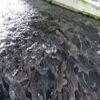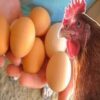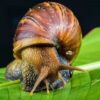Cauliflower pedicels are the slender stalks that connect individual florets to the main stem or curd of the cauliflower plant. These structures play a crucial role in the development and arrangement of the cauliflower head, scientifically known as Brassica oleracea var. botrytis, a member of the Brassicaceae family.
This family also includes broccoli, kale, cabbage, and Brussels sprouts. Pedicels are integral to the plant’s anatomy, serving as conduits for nutrients and water, and playing a key role in the overall morphology and functionality of the cauliflower.
Botanically, pedicels are the thin, stem-like appendages that attach each floret to the central curd. They support the florets and ensure their optimal arrangement for growth. The pedicels are composed of various tissues, including vascular tissues, which are essential for the transport of water, nutrients, and photosynthates (products of photosynthesis) between the florets and the rest of the plant.
This vascular system comprises xylem and phloem, which transport water and nutrients, and sugars, respectively. This transport system is vital for the growth and development of the cauliflower head.
The length and strength of the pedicels can vary depending on the specific variety of cauliflower and growing conditions. Strong, well-developed pedicels are crucial for maintaining the structural integrity of the cauliflower head, ensuring that the florets remain securely attached and properly arranged.
The arrangement of florets facilitated by the pedicels contributes to the compact, dome-shaped appearance characteristic of cauliflower.
In terms of texture and composition, cauliflower pedicels are fibrous and firm, providing support and structural stability. This fibrous nature is due to the presence of cellulose and lignin in the cell walls, which contribute to the rigidity and strength of the pedicels. Although not typically consumed separately, pedicels are edible and can be included in various culinary applications where their texture can be utilized, such as in soups or broths.
From a nutritional perspective, cauliflower pedicels, like the rest of the plant, are rich in dietary fiber, vitamins (especially C and K), and minerals (such as potassium and magnesium). They also contain phytonutrients, including glucosinolates and isothiocyanates, which have been studied for their potential health benefits, including anti-cancer properties.
The development of pedicels is influenced by genetic and environmental factors. Optimal growing conditions, including adequate water, nutrients, and appropriate temperature ranges, are essential for the development of strong and healthy pedicels. Stress conditions, such as drought or nutrient deficiencies, can affect pedicel growth and, consequently, the overall quality of the cauliflower head.
In agricultural practices, the integrity of pedicels is important for both the harvest and post-harvest handling of cauliflower. Strong pedicels reduce the likelihood of floret detachment during harvesting, transportation, and storage, thus maintaining the quality and marketability of the cauliflower. Moreover, understanding the factors that influence pedicel development can aid in breeding programs aimed at improving cauliflower varieties for better yield and quality.
Cauliflower pedicels also play a role in the plant’s reproductive biology. If left to mature, the pedicels would support the development of flowers and ultimately seeds. This aspect is crucial for seed production and the propagation of cauliflower plants.
In conclusion, cauliflower pedicels are essential anatomical structures that support and nourish the florets, contributing to the growth, development, and overall morphology of the cauliflower head.
Their structural and functional roles, coupled with their nutritional value, underscore their importance in both the botanical and agricultural contexts. Understanding and optimizing the conditions for pedicel development can lead to improvements in cauliflower cultivation, ensuring high-quality produce for consumers.
The Economic Importance and Uses of Cauliflower Pedicels

1. Nutrient Transport: Pedicels are crucial for transporting water, nutrients, and sugars to the florets, ensuring proper growth and quality of the cauliflower head.
2. Structural Support: The fibrous nature of pedicels provides structural integrity to the cauliflower, helping maintain its compact shape and preventing floret detachment.
3. Culinary Uses: Pedicels are edible and can be used in soups, stocks, and broths, adding nutrients and flavor to various dishes.
4. Agricultural Efficiency: Healthy pedicels reduce floret loss during harvesting, handling, and transportation, improving overall yield and marketability.
5. Animal Feed: Leftover pedicels can be repurposed as animal feed, providing a nutritious supplement for livestock.
6. Compost Material: Pedicels can be composted to create nutrient-rich soil amendments, promoting sustainable agriculture.
7. Biofuel Production: The fibrous content of pedicels makes them suitable for conversion into biofuels, providing an alternative energy source.
8. Biodegradable Products: Pedicels can be processed into biodegradable materials, reducing reliance on plastic and supporting environmental sustainability.
9. Pharmaceutical Uses: Nutrients and phytonutrients in pedicels can be extracted for use in dietary supplements and pharmaceuticals.
10. Natural Mulch: Shredded pedicels can be used as mulch to retain soil moisture and suppress weeds in gardens and farms.
11. Textile Industry: Fibers from pedicels can be processed into eco-friendly textiles and fabrics.
12. Paper Production: The cellulose content in pedicels can be used to produce sustainable paper products.
13. Bioplastic Development: Pedicels can be utilized in the production of bioplastics, contributing to the reduction of plastic pollution.
14. Soil Conditioner: Decomposed pedicels enrich soil fertility and improve its structure, benefiting crop growth.
15. Green Manure: Incorporating pedicels into the soil as green manure adds organic matter and nutrients, enhancing soil health.
16. Pest Repellent: Extracts from pedicels can be used to develop natural pest repellents, supporting organic farming practices.
17. Craft Supplies: Pedicels can be used in craft projects and botanical art, providing a unique, natural material.
18. Educational Material: Pedicels are used in botanical studies to teach plant anatomy and nutrient transport mechanisms.
Read Also: Why Are Honey Bees Important
The Products and By-products That Can Be Derived From Cauliflower Pedicels

1. Compost: Pedicels are decomposed to produce nutrient-rich compost for gardening and farming.
2. Animal Feed: Ground or chopped pedicels are used as feed for livestock, providing a nutritious supplement.
3. Organic Mulch: Pedicels are used as mulch to protect soil, retain moisture, and suppress weeds.
4. Dietary Fiber Supplements: Processed pedicels are turned into fiber supplements to aid in digestion and improve gut health.
5. Biofuel: Pedicels are converted into biofuel through biochemical processes like anaerobic digestion.
6. Biodegradable Packaging: Processed fibers from pedicels are used to make eco-friendly packaging materials.
7. Cellulose: Extracted cellulose from pedicels is used in the production of paper and other cellulose-based products.
8. Natural Pesticides: Pedicel extracts are formulated into natural pesticides to protect crops.
9. Skincare Products: Antioxidant-rich extracts from pedicels are used in creams, lotions, and other skincare items.
10. Food Thickeners: Pedicels are processed into natural thickeners for soups, sauces, and other foods.
11. Textile Fibers: Pedicel fibers are processed into sustainable textiles for clothing and other fabric products.
12. Green Manure: Chopped pedicels are plowed into fields to enhance soil fertility.
13. Craft Materials: Pedicels are dried and used in crafting and botanical art projects.
14. Educational Kits: Pedicels are included in educational kits for teaching plant biology and anatomy.
15. Plant-Based Stabilizers: Extracted compounds from pedicels are used as stabilizers in processed foods.
16. Natural Repellents: Pedicel extracts are used to create natural repellents for pests and insects.
17. Industrial Enzymes: Pedicels are used to produce enzymes for industrial applications, such as in detergents and bio-processing.
Read Also: How Do Honey Bees Make Honey
Frequently Asked Questions (FAQ’s) About Cauliflower Pedicels

1. What are cauliflower pedicels?
Cauliflower pedicels are the slender stalks that connect individual florets to the main stem or curd of the cauliflower plant.
2. Are cauliflower pedicels edible?
Yes, cauliflower pedicels are edible and can be used in soups, stocks, and broths.
3. How do cauliflower pedicels contribute to plant growth?
Pedicels transport water, nutrients, and sugars to the florets, ensuring proper growth and development.
4. Can cauliflower pedicels be used as animal feed?
Yes, leftover pedicels can be repurposed as nutritious animal feed.
5. What products can be made from cauliflower pedicels?
Products like compost, biofuel, biodegradable packaging, dietary fiber supplements, and textiles can be made from pedicels.
6. How are pedicels used in agriculture?
Pedicels are used as mulch, green manure, and compost to enhance soil health and support sustainable farming.
7. Are there industrial uses for cauliflower pedicels?
Yes, pedicels can be processed to produce cellulose, paper, textiles, and bioplastics.
8. Can pedicels be used in skincare products?
Antioxidant-rich extracts from pedicels are used in skincare products like creams and lotions.
9. How do pedicels help in reducing waste?
Utilizing pedicels in various products helps reduce agricultural waste and supports zero-waste practices.
10. Can pedicels be used to develop natural pesticides?
Yes, extracts from pedicels can be formulated into natural pesticides to protect crops.
Read Also: Why is it Often Easier to Start a Fitness Program Than it is to Maintain One?





